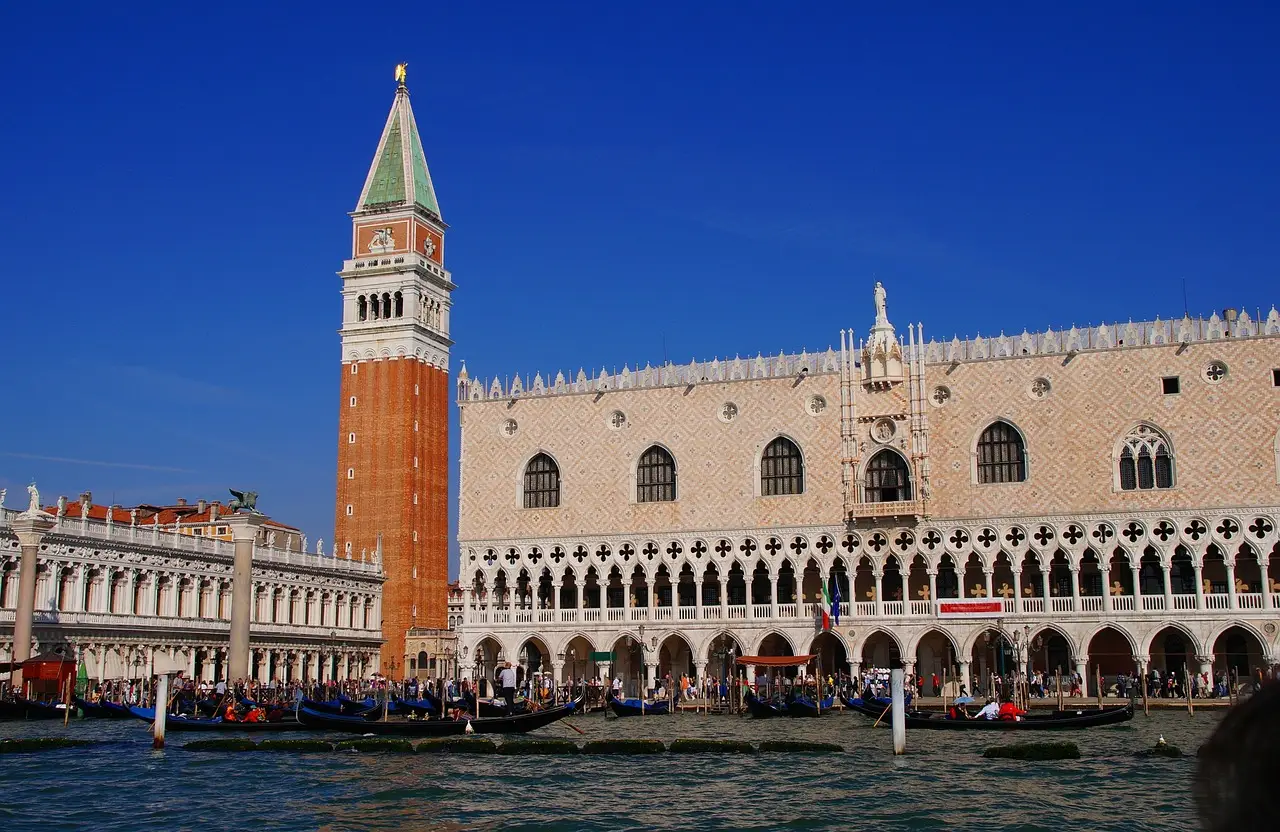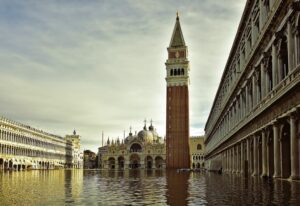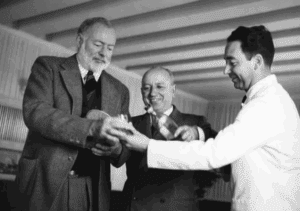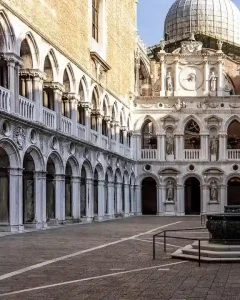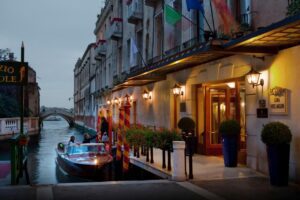Venice’s Vanishing Locals: How Overtourism Is Changing the Soul of the Floating City
At sunset, Venice still glows with the same impossible beauty it has for centuries — the light spilling across the water, the domes of San Marco shimmering like gold. But look closer, and something has changed. Many of the windows are dark. The laughter in the courtyards has faded. Behind the postcard view, the city is quietly emptying out.
Venice is often described as a living museum — but for many Venetians, it feels less “living” every year. The crowds have never been bigger, yet the community has never been smaller. What happens when the world’s most beautiful city loses the very people who make it real?
📉 The Numbers Tell the Story
In the 1950s, over 175,000 people lived in Venice’s historic center. Today, there are fewer than 50,000. The decline hasn’t slowed — roughly 1,000 residents leave every year. In the time it takes to cross the Grand Canal, another family may have packed up and left.
Walk through Castello or Santa Croce after dark and you’ll see it: entire buildings with no lights on. Staircases that echo. Streets that feel more like corridors of a hotel than the alleys of a living neighborhood.
🏠 Why Venetians Are Leaving
1. The Housing Crisis: Locals Priced Out
Venice’s housing market has been hijacked by short-term rentals. In some districts, nearly one in three apartments is now a tourist property. Rents have tripled in two decades, making it almost impossible for young Venetians to stay. Buying is out of reach for most families — a one-bedroom flat in Dorsoduro can cost as much as an apartment in Paris.
2. Everyday Life Interrupted
Getting groceries, catching a boat, or even walking to school has become an obstacle course. Cruise ships once disgorged thousands at a time into Piazza San Marco (before their partial ban). Celebrity weddings close off bridges; film crews occupy canals. Even the traghetti — simple gondola ferries Venetians use to cross the Grand Canal — have been swarmed by tourists chasing TikTok’s “€2 gondola ride.”
3. A City of Souvenirs
In neighborhoods that once had butchers, bakeries, and bookstores, souvenir stalls and designer boutiques now dominate. The local economy revolves almost entirely around tourism. Fewer artisans, fewer families, fewer reasons for residents to stay.
🌍 Overtourism in Numbers
- Annual visitors: over 20 million
- Peak days: up to 80,000 in a single day — more than the entire resident population
- Short stays: most visitors stay less than 24 hours
- Day-tripper fee: new €5–€10 charge to regulate same-day visits
Venice receives the same number of visitors in one year that it took the entire Roman Empire a century to host. It’s a staggering figure — and one the city was never designed to handle.
💔 The Human Side of the Exodus
Venetian life has always revolved around its campi — the small squares where children play, neighbors gossip, and cats stretch out under the sun. But one by one, these rhythms are fading. When families move away, they take more than furniture; they take the city’s heartbeat.
Empty apartments mean no footsteps on the stairs, no laundry strung between windows, no one to water the plants on the balcony. A Venetian grandmother once said, “When the lights go out in a campo, it’s like a candle blown from the lagoon.”
For the few who remain, resilience is an everyday act. They still queue at the fish stalls in Rialto Market before sunrise. They still stop for coffee at their neighborhood bacaro. They still greet each other by name. But each year, there are fewer greetings to return.
⚖️ What’s Being Done — and Is It Enough?
City officials have introduced a handful of measures to balance tourism and local life:
- The Day-Tripper Fee: starting in 2025, non-overnight visitors must pay to enter the city during peak days.
- Short-Term Rental Limits: proposed caps on Airbnb-style apartments to preserve housing for locals.
- Spreading Tourism: promoting lesser-known districts and lagoon islands to ease crowding in San Marco and Rialto.
Critics argue the steps are symbolic, not structural. For some residents, it feels like trying to stop the tide with sandbags. Others see hope in small victories — like the grassroots movement Poveglia per Tutti, which reclaimed the haunted island of Poveglia as a locals-only park, proof that community action can still make waves.
💡 Why This Matters
Venice’s beauty doesn’t live only in its architecture — it lives in its people. The gondolier who knows every current. The artisan who still weaves velvet at Tessitura Bevilacqua. The family that has served espresso at the same corner café for four generations. Lose them, and the city becomes a stage set without actors.
Tourism isn’t the enemy. It’s part of Venice’s story, its survival, its magic. But it must coexist with those who call the city home 365 days a year. Because when Venice stops being lived in, it stops being Venice.
🌿 How Visitors Can Help
- Stay Overnight: Support the local economy instead of rushing through on a cruise stop.
- Explore Beyond St. Mark’s: Wander through Cannaregio, Dorsoduro, or Castello to see the real city.
- Support Local Artisans: Choose handmade goods, visit workshops, and book hands-on experiences.
- Respect the Rhythm: Venice isn’t a theme park — it’s a fragile ecosystem. Move slowly. Listen. Observe.
💬 The Question Every Traveler Should Ask
Venice will never stop being beautiful. But the question now isn’t whether it will survive — it’s how it will survive. Will it remain a city of residents, artisans, and traditions, or become an open-air museum visited but never lived in?
The answer depends on us — visitors, guides, locals, and dreamers alike. Every thoughtful choice, every respectful step, helps keep Venice a place where children still play in the campi, where neighbors greet one another from their balconies, and where life, not just tourism, continues to flow like the water beneath its bridges.
👉 Discover Venice Responsibly with a Local Private Guide
Venice’s Vanishing Locals: How Overtourism Is Changing the Soul of the Floating City
At sunset, Venice still glows with the same impossible beauty it has for centuries — the light spilling across the water, the domes of San Marco shimmering like gold. But look closer, and something has changed. Many of the windows are dark. The laughter in the courtyards has faded. Behind the postcard view, the city is quietly emptying out.
Venice is often described as a living museum — but for many Venetians, it feels less “living” every year. The crowds have never been bigger, yet the community has never been smaller. What happens when the world’s most beautiful city loses the very people who make it real?
📉 The Numbers Tell the Story
In the 1950s, over 175,000 people lived in Venice’s historic center. Today, there are fewer than 50,000. The decline hasn’t slowed — roughly 1,000 residents leave every year. In the time it takes to cross the Grand Canal, another family may have packed up and left.
Walk through Castello or Santa Croce after dark and you’ll see it: entire buildings with no lights on. Staircases that echo. Streets that feel more like corridors of a hotel than the alleys of a living neighborhood.
🏠 Why Venetians Are Leaving
1. The Housing Crisis: Locals Priced Out
Venice’s housing market has been hijacked by short-term rentals. In some districts, nearly one in three apartments is now a tourist property. Rents have tripled in two decades, making it almost impossible for young Venetians to stay. Buying is out of reach for most families — a one-bedroom flat in Dorsoduro can cost as much as an apartment in Paris.
2. Everyday Life Interrupted
Getting groceries, catching a boat, or even walking to school has become an obstacle course. Cruise ships once disgorged thousands at a time into Piazza San Marco (before their partial ban). Celebrity weddings close off bridges; film crews occupy canals. Even the traghetti — simple gondola ferries Venetians use to cross the Grand Canal — have been swarmed by tourists chasing TikTok’s “€2 gondola ride.”
3. A City of Souvenirs
In neighborhoods that once had butchers, bakeries, and bookstores, souvenir stalls and designer boutiques now dominate. The local economy revolves almost entirely around tourism. Fewer artisans, fewer families, fewer reasons for residents to stay.
🌍 Overtourism in Numbers
- Annual visitors: over 20 million
- Peak days: up to 80,000 in a single day — more than the entire resident population
- Short stays: most visitors stay less than 24 hours
- Day-tripper fee: new €5–€10 charge to regulate same-day visits
Venice receives the same number of visitors in one year that it took the entire Roman Empire a century to host. It’s a staggering figure — and one the city was never designed to handle.
💔 The Human Side of the Exodus
Venetian life has always revolved around its campi — the small squares where children play, neighbors gossip, and cats stretch out under the sun. But one by one, these rhythms are fading. When families move away, they take more than furniture; they take the city’s heartbeat.
Empty apartments mean no footsteps on the stairs, no laundry strung between windows, no one to water the plants on the balcony. A Venetian grandmother once said, “When the lights go out in a campo, it’s like a candle blown from the lagoon.”
For the few who remain, resilience is an everyday act. They still queue at the fish stalls in Rialto Market before sunrise. They still stop for coffee at their neighborhood bacaro. They still greet each other by name. But each year, there are fewer greetings to return.
⚖️ What’s Being Done — and Is It Enough?
City officials have introduced a handful of measures to balance tourism and local life:
- The Day-Tripper Fee: starting in 2025, non-overnight visitors must pay to enter the city during peak days.
- Short-Term Rental Limits: proposed caps on Airbnb-style apartments to preserve housing for locals.
- Spreading Tourism: promoting lesser-known districts and lagoon islands to ease crowding in San Marco and Rialto.
Critics argue the steps are symbolic, not structural. For some residents, it feels like trying to stop the tide with sandbags. Others see hope in small victories — like the grassroots movement Poveglia per Tutti, which reclaimed the haunted island of Poveglia as a locals-only park, proof that community action can still make waves.
💡 Why This Matters
Venice’s beauty doesn’t live only in its architecture — it lives in its people. The gondolier who knows every current. The artisan who still weaves velvet at Tessitura Bevilacqua. The family that has served espresso at the same corner café for four generations. Lose them, and the city becomes a stage set without actors.
Tourism isn’t the enemy. It’s part of Venice’s story, its survival, its magic. But it must coexist with those who call the city home 365 days a year. Because when Venice stops being lived in, it stops being Venice.
🌿 How Visitors Can Help
- Stay Overnight: Support the local economy instead of rushing through on a cruise stop.
- Explore Beyond St. Mark’s: Wander through Cannaregio, Dorsoduro, or Castello to see the real city.
- Support Local Artisans: Choose handmade goods, visit workshops, and book hands-on experiences.
- Respect the Rhythm: Venice isn’t a theme park — it’s a fragile ecosystem. Move slowly. Listen. Observe.
💬 The Question Every Traveler Should Ask
Venice will never stop being beautiful. But the question now isn’t whether it will survive — it’s how it will survive. Will it remain a city of residents, artisans, and traditions, or become an open-air museum visited but never lived in?
The answer depends on us — visitors, guides, locals, and dreamers alike. Every thoughtful choice, every respectful step, helps keep Venice a place where children still play in the campi, where neighbors greet one another from their balconies, and where life, not just tourism, continues to flow like the water beneath its bridges.
👉 Discover Venice Responsibly with a Local Private Guide
❓ FAQs — Overtourism and Local Life in Venice
Why are so many Venetians leaving the city?
Rising rents, a shrinking housing market, and the growth of short-term rentals have made daily life difficult for locals. Many families are priced out, and traditional shops have been replaced by souvenir stores. Yet the real Venice still survives — in neighborhoods like Cannaregio, Castello, and Sant’Elena, where life continues at a slower rhythm. To understand this side of the city, join our Explore Venice Off the Beaten Path — A Captivating Orientation Tour and meet the artisans and residents who keep Venice’s heart beating.
How can visitors support Venice’s local community?
Choose experiences that give back to Venetians. Stay overnight instead of day-tripping, dine in family-run restaurants, and buy handmade crafts instead of mass-produced souvenirs. You can also book hands-on experiences such as our Traditional Marbled Paper Making Workshop or Create Your Own Masterpiece — Venetian Mask Workshop, where your visit directly supports local artisans and preserves centuries-old craftsmanship.
Is it still possible to experience authentic Venice despite the crowds?
Absolutely — you just need to see the city through local eyes. Explore quiet morning markets, hidden courtyards, and lesser-known islands far from the main tourist trail. Our Venice Sunset Tour on a Traditional Bragozzo Boat or Venetian Rowing Experience reveal a side of Venice few travelers ever see — peaceful, poetic, and profoundly real.

